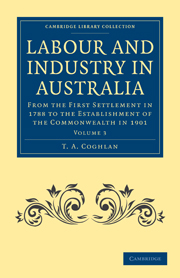 Labour and Industry in Australia
Labour and Industry in Australia XIII - RAILWAY EXTENSION AND PUBLIC WORKS POLICY
Published online by Cambridge University Press: 07 October 2011
Summary
Railway construction made very little progress during the first years of this period; the 243 miles worked in 1861 were extended to 519 in 1866, an increase of only 276 miles in five years, of which 156 miles were Victorian extensions. In 1871 the mileage open had reached 1030, an increase of 511 miles in five years, of which 215 miles were in New South Wales, 168 in Queensland, and 77 in South Australia. During these years only 6 miles of road were opened for traffic in Victoria. Construction had been going on in that colony, but it was not until 1873 that the lines were ready for use. After twenty-one years of effort, there were hardly 1100 miles of railway in the whole continent of Australia. The lines in their farthest extension did not run more than 180 miles from the sea and served only an inconsiderable area. Money for the construction of the lines had been hard to procure, and the interest charged was relatively high, while the cost of constructing the railways was heavy. The railways had competition in the horse and bullock teams, and this competition would have been keen, had the maintenance of the main lines of roads giving access from the capitals to the interior been properly attended to. The charges for conveyance of goods on the railways were determined by a consideration of the charges made by the teams.
- Type
- Chapter
- Information
- Labour and Industry in AustraliaFrom the First Settlement in 1788 to the Establishment of the Commonwealth in 1901, pp. 1218 - 1228Publisher: Cambridge University PressPrint publication year: 2011First published in: 1918
